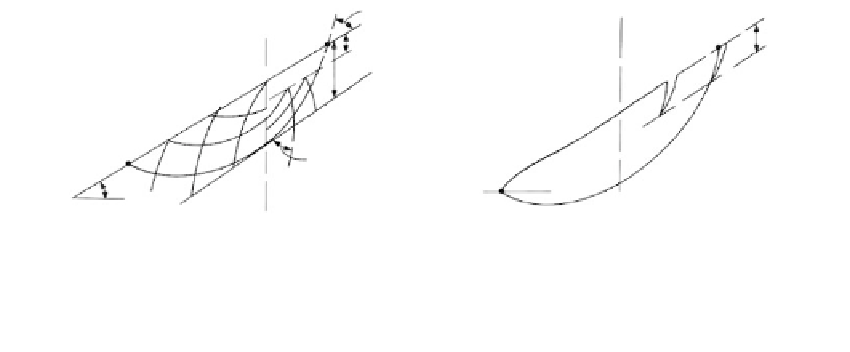Environmental Engineering Reference
In-Depth Information
shear strength along the failure surface, and the magnitude of the driving forces. Statically
determinate failure forms may be classified as:
Infinite slope — translation on a plane parallel to the ground surface whose
length is large compared with its depth below the surface (end effects can be neg-
lected)
(Figure 9.63)
(Morgenstern and Sangrey, 1978).
●
Finite slope, planar surface — displacement of one or more blocks, or wedge-
shaped bodies, along planar surfaces with finite lengths
(Figure 9.66).
●
Finite slope, curved surface — rotation along a curved surface approximated by
a circular arc, log-spiral, or other definable cylindrical shape (
Figure 9.76)
.
●
Failure origin
: As stresses are usually highest at the toe of the slope, failure often begins
there and progresses upslope, as illustrated in
Figure 9.60,
which shows the distribution
of active and passive stresses in a slope where failure is just beginning. Failures can begin
at any point along a failure surface, however, where the stresses exceed the peak strength.
Because failure often is progressive, it usually occurs at some average shear strength that
can be considerably less than the peak strength measured by testing techniques.
Limit Equilibrium Analysis
Most analytical methods applied to evaluate slope stability are based on limiting equilib-
rium, i.e., on equating the driving or shearing forces due to water and gravity to the resist-
ing forces due to cohesion and friction.
Shearing forces
result from gravity forces and internal pressures acting on a mass
bounded by a failure surface. Gravity forces are a function of the weight of the materials,
slope angle, depth to the failure surface, and in some cases, slope height. Pressures
develop in joints in rock masses from water, freezing, swelling materials, or hydration of
minerals and, in soils, from water in tension cracks and pores.
Resisting forces
, provided by the shear strength along the failure surface, are decreased
by an increase in pore pressures along the failure surface, by lateral strains in overconsol-
idated clays in clay shales, by dissolution of cementing agents and leaching, or by the
development of tension cracks (which serve to reduce the length of the resisting surface).
Safety factor against rupture, given as
shearing strength available along the sliding surface
shearing stresses tending to produce failure along the surface
FS
(9.1)
Passive
zone
Active
zone
45 +
/2
x
x
z
0
B
B
z
0
Passive
zone
Active
zone
z
1
Compression
−
Expansion
Failure
surface
+
A
45 +
/2
+
i >
A
i
x
x
(a)
(b)
FIGURE 9.60
Active and passive stresses acting on a slope. The passive resistance at the lower portions is most significant.
(a) Distribution of stresses on slope with
i
>φ
(failure beginning). (b) A case of rupture where
indicates zones
of passive stress and
indicates zones of active stress, subjected to tension cracks.


